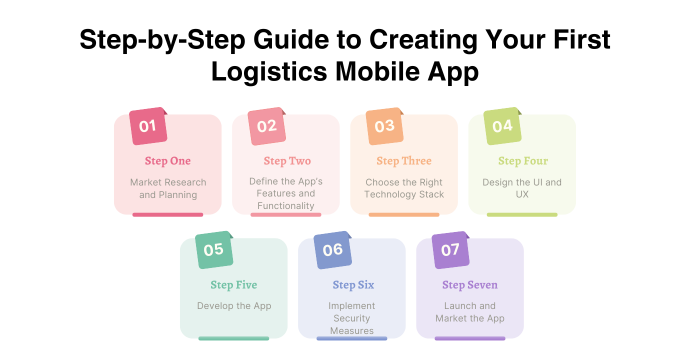
In the ever-evolving world of logistics, the demand for streamlined, efficient, and innovative solutions continues to rise. As businesses strive to optimize their supply chains and enhance customer satisfaction, logistics mobile apps have emerged as a game-changer.
These apps offer real-time tracking, improved communication, and operational efficiency. If you’re considering developing your first logistics mobile app in 2024, this comprehensive guide will walk you through the essential steps to create a successful and SEO-friendly application.
Understanding the Basics of Logistics Mobile App
Before diving into the development process, it’s crucial to understand what a logistics mobile app entails. These apps are designed to manage and monitor various logistics operations, such as inventory management, shipment tracking, fleet management, and delivery scheduling. The primary goal is to streamline logistics processes, reduce operational costs, and enhance overall efficiency.
Essential Features for a Successful Logistics Mobile App
To ensure your logistics app stands out and meets the needs of users, consider incorporating the following key features:
- Real-Time Tracking: Provide users with the ability to track shipments, vehicles, and inventory in real-time.
- Route Optimization: Streamline delivery routes to minimize travel time and fuel expenses.
- Fleet Management: Manage and monitor your fleet of vehicles, including maintenance schedules and driver assignments.
- Inventory Management: Keep track of inventory levels, stock locations, and reorder points.
- In-App Communication: Enable seamless communication between drivers, dispatchers, and customers.
- Proof of Delivery: Allow drivers to capture electronic signatures and photos as proof of delivery.
- Analytics and Reporting: Generate detailed reports and analytics to help optimize logistics operations.
Read More: The Importance of API Integration in App Development
Step-by-Step Guide to Creating Your First Logistics Mobile App

Step 1: Market Research and Planning
The first step in developing a logistics mobile app is conducting thorough market research. Understand the current trends, user needs, and competitors in the logistics industry. Identify the gaps in the market that your app can fill and define your target audience.
Next, create a detailed project plan outlining the app’s features, development timeline, budget, and resources required. This plan will serve as a roadmap throughout the development process.
Step 2: Define the App’s Features and Functionality
Based on your market research, decide on the core features and functionality of your logistics app. Prioritize features that will provide the most value to users and differentiate your app from competitors. Create a list of must-have features and optional features that can be added in future updates.
Step 3: Choose the Right Technology Stack
Selecting the appropriate technology stack is crucial for the success of your logistics app. Consider the following technologies:
- Frontend: React Native, Flutter, or Swift for iOS and Kotlin for Android.
- Backend: Node.js, Ruby on Rails, or Django for building robust server-side logic.
- Database: MySQL, PostgreSQL, or MongoDB for managing data.
- Cloud Services: Choose AWS, Google Cloud, or Azure for hosting and scaling your app.
Ensure that your chosen technology stack aligns with your app’s requirements and future scalability needs.
Step 4: Design the User Interface (UI) and User Experience (UX)
A well-designed UI/UX is essential for user satisfaction and retention. Work with experienced designers to create an intuitive and visually appealing interface. Prioritize ease of use, accessibility, and smooth navigation. Incorporate feedback from potential users during the design phase to ensure your app meets their expectations.
Step 5: Develop the App
With the design finalized, it’s time to begin the development process. This phase involves writing code, integrating features, and testing the app. Follow these sub-steps:
- Frontend Development: Build the app’s user interface based on the design specifications.
- Backend Development: Develop the server-side logic, APIs, and database schema.
- Integration: Connect the frontend and backend, ensuring smooth data flow and functionality.
- Testing: Carry out extensive testing, including unit testing, integration testing, and user acceptance testing (UAT). Identify and fix bugs to ensure a seamless user experience.
Step 6: Implement Security Measures
Security is paramount in logistics apps, given the sensitive data they handle. Adopt strong security practices, including data encryption, secure authentication, and frequent security audits. Ensure compliance with industry standards and regulations to protect user data and build trust.
Step 7: Launch and Market the App
After the app is fully developed and tested, start preparing for its launch. Develop a marketing strategy to promote the app and draw in users. Utilize various marketing channels, including social media, content marketing, email campaigns, and partnerships with logistics companies.
SEO Best Practices for Your Logistics Mobile App
To ensure your logistics app ranks well in search engine results and attracts organic traffic, follow these SEO best practices:
- Keyword Research: Identify relevant keywords related to logistics, such as “logistics app,” “shipment tracking,” and “fleet management.” Incorporate these keywords naturally into your app’s description, blog posts, and marketing materials.
- High-Quality Content: Create informative and valuable content related to logistics. Write blog posts, how-to guides, and case studies that address common pain points and provide solutions.
- App Store Optimization (ASO): Optimize your mobile app’s listing on app stores. Use a descriptive and keyword-rich title, write a compelling description, and include high-quality screenshots and videos.
- Backlinks: Build backlinks from reputable websites and industry blogs. This will improve your app’s authority and search engine ranking.
- User Reviews and Ratings: Urge users to leave favorable reviews and ratings on app stores. High ratings and positive feedback will boost your app’s credibility and visibility.
Conclusion
Creating your first logistics mobile app in 2024 is an exciting and rewarding endeavor. By following this step-by-step guide, you can develop a robust and user-friendly app that meets the needs of the logistics industry.
Remember to conduct thorough market research, prioritize essential features, choose the right technology stack, and focus on security and SEO best practices.
With careful planning and execution, your logistics app can become a valuable asset for businesses and a key driver of growth and efficiency in the logistics sector.